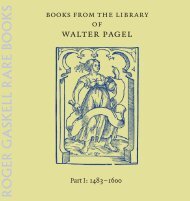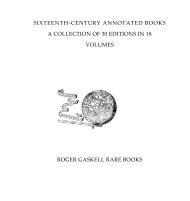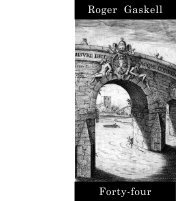pdf - Roger Gaskell Rare Books
pdf - Roger Gaskell Rare Books
pdf - Roger Gaskell Rare Books
You also want an ePaper? Increase the reach of your titles
YUMPU automatically turns print PDFs into web optimized ePapers that Google loves.
volume I consisted of parts 1–7; Neue Analekten vol. I (1832–1834), parts 8–13;<br />
and Neue Analekten vol. I (1832–1834) parts 14–15 (see Hessische Bibliothekssystem,<br />
HeBis). According to the BN record publication began in 1828.<br />
74<br />
GuIBERT, Nicolas (c. 1547–c. 1620)<br />
De interitu alchymiae metallorum transmutatoriae tractatus...<br />
adiuncta est eiusdem Apologia in sophistam Libavium, alchymiae<br />
refutatae furentem calumniatorem, quae loco praefationis in eiusdem<br />
tractatus esse possit.<br />
Toul: apud Sebastianum Philippe, typographum Iuratum, 1614.<br />
8vo: † 8 A–E8 F4 ; 2A–I8 (blanks 2C8, I8), 124 leaves, pp. [16] 88; 141 [3]<br />
(including the blank leaves). Woodcut device on title, woodcut initials.<br />
158 x 92mm. Light waterstaining and browning.<br />
Binding: Nineteenth century half vellum.<br />
Provenance: undeciphered signature on title dated 1739, 40 word<br />
annotation on p. 38 (second sequence) in an eighteenthcentury hand,<br />
some marginal marking and underlining.<br />
First edition. Wellcome 2981; Neville I, p. 558.<br />
Originally a respected alchemist, Guibert became a vehement critic of the<br />
profession. His Wrst published attack on alchemy was his Alchymia ratione et<br />
experientia ita demum viriliter impugnata et expugnata (1603). This provoked a<br />
response from Libavius, his Defensio alchymiae (1604) to which the present work<br />
is Guibert’s justiWcation of his own position. This exchange was important in<br />
the continuing debate over the occult sciences and the emergence of modern<br />
science. Guibert’s works served to reinforce signiWcant, but not widely held<br />
ideas, most importantly his demonstration that metals were distinct species<br />
and not transmutable. This work begins with his ‘Apologia’, the refutation of<br />
Libavius, followed by ‘Alchymia metallorum transmutatoria’.<br />
Guibert was a native of Lorraine, studied medicine at Perugia and was<br />
appointed alchemist to the Duke of Augsburg in 1579. At some time he<br />
returned to Lorraine and died at Vaucouleurs, close to Toul where this book<br />
was printed. Only about 20 books had been printed at Toul by this time.<br />
Thorndike, VI, pp. 245–7; Martin Fichman, DSB 5: 579–80.<br />
75<br />
GuIDI, Guido, or VIDIuS, Vidus, (c. 1500–1569)<br />
De anatome corporis humani libri VII. Nunc primum in lucem<br />
editi. Atque LXXVIII. Tabulis in aes incisis illustrati et exornati.<br />
Venice: apud Iuntas, 1611.<br />
Folio: engraved titleleaf and a 6 A–2D 6 2E 4 , 173 leaves, pp. [12] 342 (i.e.<br />
332, 325–334 omitted). Woodcut headpieces and initials, 78 full page engravings<br />
printed in the text. The engraved title is signed ‘Franco. Vallegio<br />
et Catarin Doino. sculpsit’, the anatomical engravings are unsigned.







